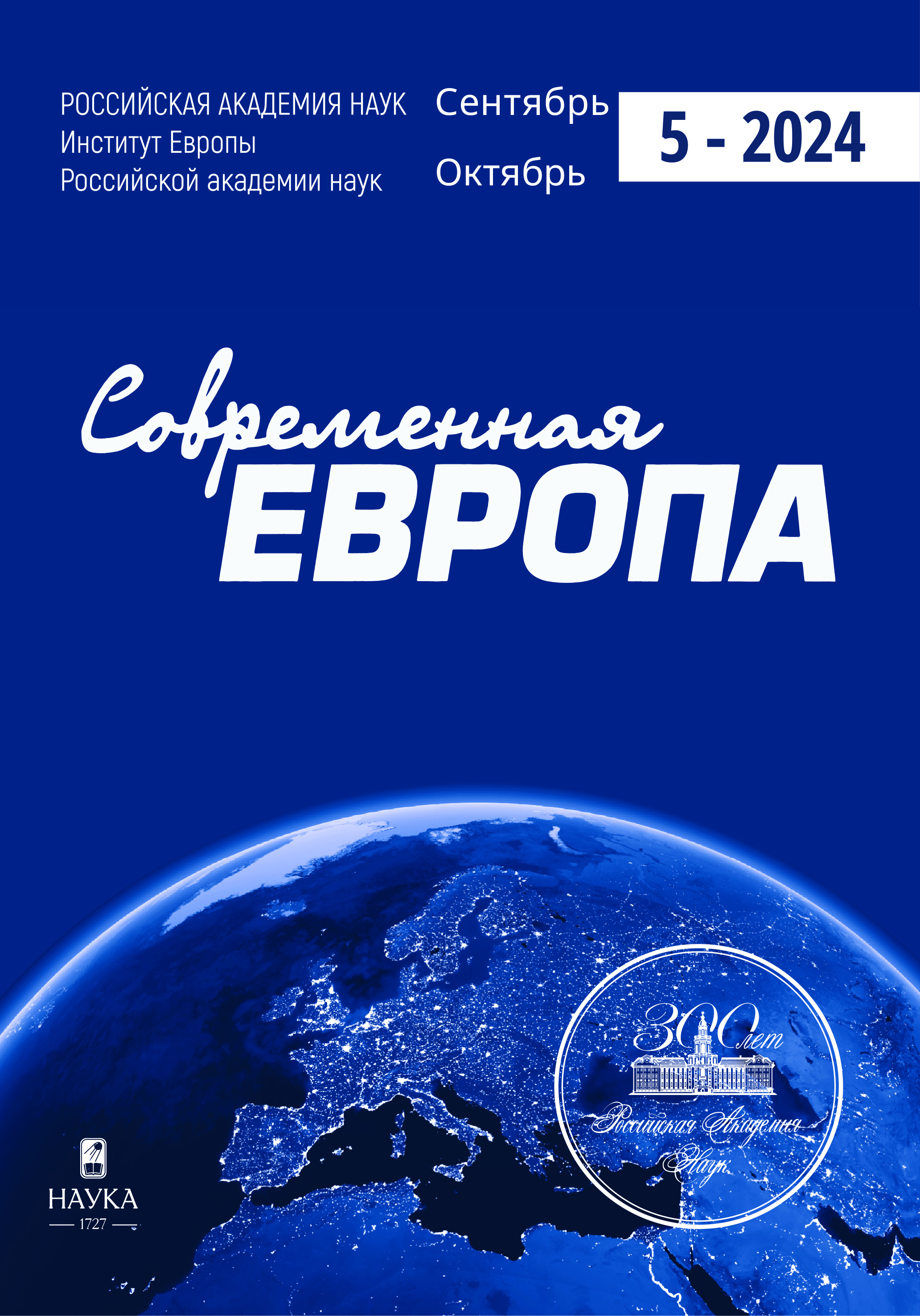Geopolitical Initiative “Global Gateway” of the EU Commission
- 作者: Kondratieva N.B1
-
隶属关系:
- Institute of Europe, Russian Academy of Sciences
- 期: 编号 5 (126) (2024)
- 页面: 137-149
- 栏目: PROBLEMS OF ECONOMY
- URL: https://kld-journal.fedlab.ru/0201-7083/article/view/652321
- DOI: https://doi.org/10.31857/S0201708324050115
- ID: 652321
如何引用文章
详细
The article is devoted to the investment strategy of the European Union “Global Gateway”. Official documents and publicly available information on flagship projects served as an analytical basis for identifying the objectives of the relevant initiative of the European Commission, announced in 2021. The failure of experts' attempts to operationalise the strategy was noted due to the lack of convincing facts of its implementation and measurable results. The author discusses the reasons for the unsuccessful start of the Global Gate initiative. They consist in the unfavorable political environment, the limited and narrow focus of financial incentives from the EU, which turn off private investment. The approach to relations with external countries, called open strategic autonomy, applied by the “geopolitical Commission” under the leadership of Ursula von der Leyen, conserve the concept of the EU's normative power as a basis, is complemented by a semantic focus on projects that meet the interests of restoring the EU's leadership position in global competition. During 2022‒2023, the European think tanks supported the initiative by making recommendations for attracting capital to the proposed projects. Nevertheless, economic actors, having demonstrated interest, remained in the position of observers. Thus, the initiative did not overcome the initial stage of diplomatic memorandums and roadmaps. According to the author of the article, the announced reform will be formal, namely, aimed at saving the initiative, appeasing partner non-governmental organisations advocating for the UN Sustainable Development Goals, continuing scientific research, conducting communication events and fueling the technical component of flagship projects.
作者简介
N. Kondratieva
Institute of Europe, Russian Academy of Sciences
Email: nkondratieva@inbox.ru
Candidate of Sciences (Economics) Moscow, Russia
参考
- Биссон Л.С. (2020) Новая стратегия ЕС для Африки: в поисках подлинного партнерства. Современная Европа. № 3. С. 39‒50. DOI: http://dx.doi.org/10.15211/soveurope320203950
- Bisson L.S. (2020) Novaya strategiya ES dlya Afriki: v poiskah podlinnogo partnerstva [The EU's New Strategy for Africa: in Search of a Genuine Partnership], Sovremennaya Evropa, 3, pp. 39–50. DOI: http://dx.doi.org/10.15211/soveurope320203950 (In Russian).
- Громыко Ал.А., Носов М.Г. (общ. ред.) (2015) Европейский союз в поиске глобальной роли: политика, экономика, безопасность. Весь Мир, Москва. 592 с.
- Gromyko Al.A., Nosov M.G. (ed.) (2015) Evropejskij soyuz v poiske global'noj roli: politika, ekonomika, bezopasnost' [The European Union in search of a global role: politics, economics, security], Ves' Mir, Moscow, Russia. (In Russian).
- Надточей Ю.И. (2024) Европейский союз в меняющейся парадигме глобализации. Современные проблемы Европы. № 1. С. 106‒130. doi: 10.31249/ape/2024.01.06
- Nadtochej Y.I. (2024). Evropejskij soyuz v menyayushchejsya paradigme globalizacii [The European Union in the changing paradigm of globalization], Current problems of Europe, 1, pp. 106‒130. doi: 10.31249/ape/2024.01.06 (In Russian).
- Прохоренко И.Л. (2019) Новая стратегия Европейского союза в Центральной Азии: возможности и пределы «мягкой силы». Анализ и прогноз. Журнал ИМЭМО. № 4. С. 68‒80. doi: 10.20542/afij-2019-4-68-80
- Prohorenko I.L. (2019) Novaya strategiya Evropejskogo soyuza v Central'noj Azii: vozmozhnosti i predely “myagkoj sily” [The European Union’s new Central Asia strategy: possibilities and limits of "soft power"], Analysis and Forecasting. IMEMO Journal, 4, pp. 68‒80. doi: 10.20542/afij-2019-4-68-80 (In Russian).
- Dahl R.A. (1957) The Concept of Power. Behavioral Science. Vol. 2, 3. P. 201–215.
- Damro C. (2012) Market Power Europe. Journal of European public policy. Vol. 19(5). P. 682‒699.
- Freire M.R., Lopes P.D., Nascimento D., Simão L. (ed.) (2022) EU Global Actorness in a World of Contested Leadership. Palgrave Macmillan, Cham, Switzerland. 309 p. DOI: https://doi.org/10.1007/978-3-030-92997-8
- Gherasim D.-P. (2024). Global Gateway: Towards a European External Climate Security Strategy? IFRI MEMOS April. URL: https://www.ifri.org/sites/default/files/atoms/files/ifri_gherasim_global_gateway_2024.pdf (дата обращения: 17.09.2024).
- Gherasim D.-P. (2024). Global Gateway: Towards a European External Climate Security Strategy?, IFRI MEMOS April. URL: https://www.ifri.org/sites/default/files/atoms/files/ifri_gherasim_global_gateway_2024.pdf (accessed: 17.09.2024).
- Haroche P. (2020) Supranationalism Strikes Back: A Neofunctionalist Account of the European Defence Fund. Journal of European Public Policy. Vol. 27, 6. P. 853–872.
- Haroche P. (2023) A “Geopolitical Commission”: Supranationalism Meets Global Power Competition. JCMS: Journal of Common Market Studies. Vol. 61. P. 970–987. DOI: https://doi.org/10.1111/jcms.13440
- Haroche P. (2024) Geoeconomic Power Europe: When Global Power Competition Drives EU Integration. JCMS: Journal of Common Market Studies. Vol. 62. P. 938–954. DOI: https://doi.org/10.1111/jcms.13596
- Hout W. (2016) Classical approaches to development: Modernisation and dependency. The Palgrave Handbook of International Development. Ed. by J. Grugel, D. Hammett. Palgrave Macmillan, London, UK. P. 21–39. doi: 10.1057/978-1-137-42724-3_2
- Karjalainen T. (2022) The EU's Global Gateway: Building connectivity as a policy. FIIA Working paper. URL: https://www.fiia.fi/wp-content/uploads/2022/02/wp127_the-eus-global-gateway_building-connectivity-as-a-policy_tyyne-karjalainen.pdf (дата обращения: 17.09.2024).
- Karjalainen T. (2022) The EU's Global Gateway: Building connectivity as a policy, FIIA Working paper. URL: https://www.fiia.fi/wp-content/uploads/2022/02/wp127_the-eus-global-gateway_building-connectivity-as-a-policy_tyyne-karjalainen.pdf (accessed: 17.09.2024).
- Malik A., Parks B., Russell B., Lin J., Walsh K., Solomon K., Zhang S., Elston T., Goodman S. (2021) Banking on the Belt and Road: Insights from a new global dataset of 13,427 Chinese development projects. AidData at William & Mary, Williamsburg, USA. 165 p.
- Manners I. (2002) Normative Power Europe: A Contradiction in Terms? JCMS: Journal of Common Market Studies. Vol. 40, 2. P. 235–258.
- Niemann A. (2006) Explaining Decisions in the European Union. Cambridge University Press, Cambridge, UK. 384 p.
- Olivié I., Santillán O’Shea M. (2023) Development aid and geopolitics: the EU’s Global Gateway initiative. Elcano Policy Paper. URL: https://media.realinstitutoelcano.org/wp-content/uploads/2023/08/policy-paper-development-aid-and-geopolitics-the-eus-global-gateway-initiative.pdf (дата обращения: 17.09.2024).
- Olivié I., Santillán O’Shea M. (2023) Development aid and geopolitics: the EU’s Global Gateway initiative, Elcano Policy Paper. URL: https://media.realinstitutoelcano.org/wp-content/uploads/2023/08/policy-paper-development-aid-and-geopolitics-the-eus-global-gateway-initiative.pdf (accessed: 17.09.2024).
- Paikin Z., Islam S., Biscop S. (2023) Regional actor, Global player. Can the EU get the best of both worlds? CEPS Explainer. 2023-08. URL: https://cdn.ceps.eu/wp-content/uploads/2023/06/CEPS-Explainer-2023-08_Regional-actor-global-player.pdf (дата обращения: 17.09.2024).
- Schimmelfennig F., Scholtz H. (2010) Legacies and Leverage: EU Political Conditionality and Democracy Promotion in Historical Perspective. Europe-Asia Studies. Vol. 62(3). P. 443–460.
- Tagliapietra S. (2024). The European Union's Global Gateway: An institutional and economic overview. The World Economy. No. 47. P. 1326–1335. DOI: https://doi.org/10.1111/twec.13551
补充文件









